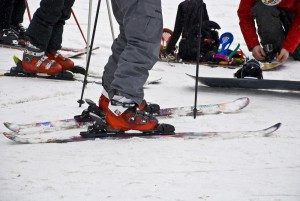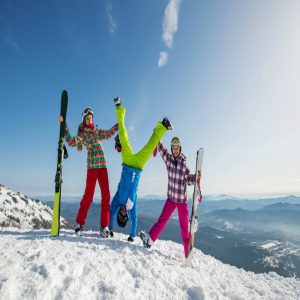Day Vs. Night
Ski and Snowboard any time of day
Most skiers live for the blue bird day. You know, that day when the sun transforms the snow into a blanket of blinding diamonds, when you need polarized lenses and sunscreen for first tracks, and when the sky puts on a crayon-box display of cobalt and indigo and robin’s egg and a thousand other indescribable shades of that coolest of colors.
You could call them “fair weather” skiers, for that is, strictly speaking, what they are. But, who can blame blue birders for reveling in the glory of kicking up sprays of snow that create prisms in the air (snowbows, if you will)? Who, after all, doesn’t love a good sunglasses tan soaked up on a crowded ski lodge deck alive with laughter and the smell of burgers grilling? And (come on, admit it), who hasn’t felt the satisfaction of watching their own shadow carve turns beside them as the sun sets over their shoulder on the last run of the day?
Yes, blue birders have the right idea. There’s something ecstatic and affirming about carving up a mountain on a sunny day. It makes life feel alive.
And yet, when the sun sets and the blue birders retire to their apres-ski bars and hot tubs, another skiing tribe emerges. This may come as a surprise to some of you. Skiing at night? Why would anyone go skiing they could be enjoying their second beer or a hot shower after ordering pizza for the kids?
The question answers itself, somewhat. As a general proposition, night skiers tend to run younger, as in, way-below-the-age-to-be-drinking-beer-or-having-children. Forget apres-ski, a good chunk of this crowd is apres-school. And yet, dismissing skiing after dark as the necessary folly of ski bums trapped in teenage bodies doesn’t capture the particular joys of making turns under the lights. No, there’s more to it than that.
To the same degree that a blue bird day bursts with exuberance, peace, and quiet envelop a mountain after dark. And here’s the strange thing: it’s not just because there are fewer skiers on the hill. The darkness itself seems to infuse night skiing with a feeling of stillness and mystery. Consider the solitary echo of a lone skier’s metal edges navigating an icy patch, heard from your chairlift perch. During the day, that same chairlift ride might be an opportunity to lift your face to the sky and bask in the expansive thrill of riding above the earth upwards, towards the heavens. But at night, as shadows play through the trees from the trailside lampposts, it’s easy to feel a twinge of mortality and doubt about where you’re headed. That is, of course, unless you happen to be sharing the chair with a special someone, in which case, you have other things on your mind.
In a practical sense, the conditions at night are rarely the quality you get at first light. If things were otherwise, the grooming crew would be out of the job. But if your skiing tastes run to the more (ahem) adventurous, or if for whatever reason your ski day has to start at 4 p.m., the fact is that at night the bumps are bigger, the “slow skiing” zones are less congested, and the patrollers are a lot more pliant when they catch you and your friends digging a huge kicker out of the ridge of snow that blue birders pushed to the trail’s edge during the day. Skiing at night is the distillation of freedom from the constraints of the daily grind.
So, you see, day skiing and night skiing each hold their own magic. Over a lifetime, you can belong to one tribe of skiers or the other, or both at once. And the beautiful thing is, that’s ok. For, whether we make turns awash in sunlight or in the shadow of LED lamps, we all know the thrill of the wind in our faces as we dive into the fall line, full of the giddy anticipation of heading back up to do it again and again, until the lifts finally close.

